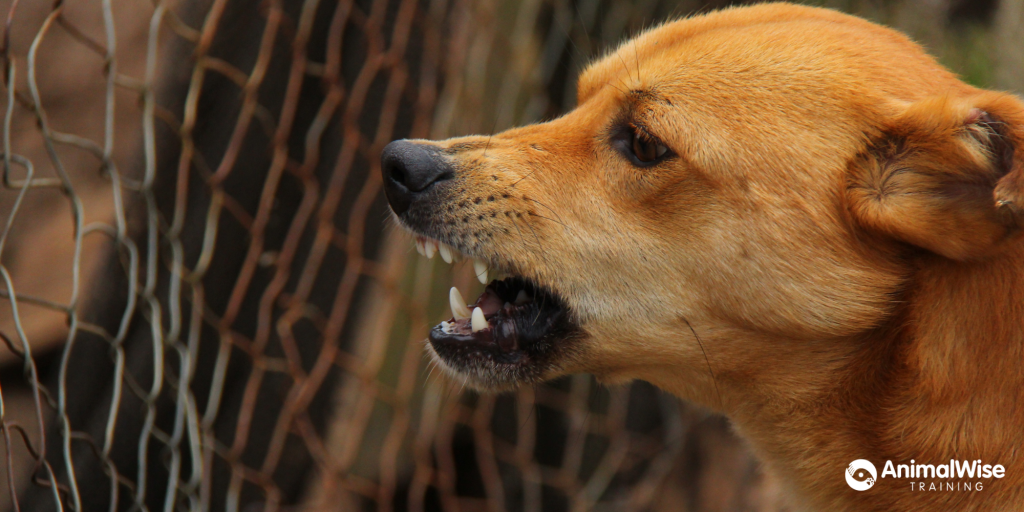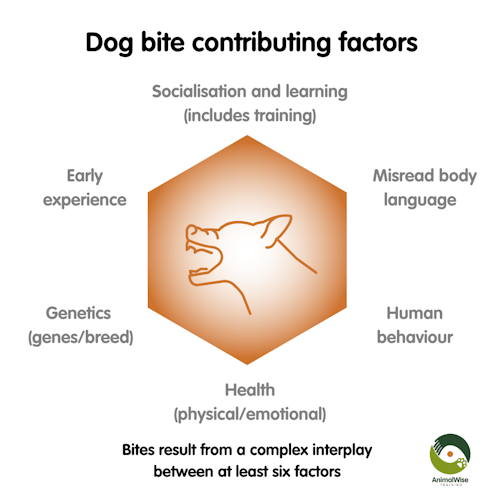The incidence of dog bites is increasing worldwide, and it’s not just genetics to blame – dog socialisation and human behaviour also play a part.
In Part 1, we discussed the notable increase in dog bites worldwide, including in Australia. This trend is concerning for dog owners and non-owners alike, including the council officers at the coalface dealing with attacks. We also discussed that while genetics play a role in dog aggression, the issue is not rooted in specific dog breeds and banning certain breeds has not stopped the wave of increasing bites.

Apart from genetics, the other issues that play a role in dog aggression are:
- Socialisation, environment, learning, and health
- Our human ability to read body language and,
- Our behaviour around dogs.
Dog bites result from a complex interplay between these multiple interacting factors. Let’s explore some of these issues in greater detail.

The role of proper socialisation and training
In addition to genetics, a lack of adequate socialisation and training can contribute to a dog’s baseline of anxiety and the unpredictability of their behaviour. Dogs that aren’t systematically and positively exposed to different people, environments, sounds and other animals from a young age may develop fear or anxiety, leading to biting in the wrong circumstance. It is important this exposure to new things is gradual and not overwhelming. It’s a good idea to always start with a puppy at a comfortable distance from new stimuli, and any signs of barking or overexcitement can indicate we’ve pushed it too far, too fast. The inability to focus on yummy dog treats is also a helpful indicator that the puppy is a little too worried about the new thing or environment.
Another often overlooked element is consistent, positive reinforcement-based training. This involves using treats, toys, attention and praise to reward good (or desired) pet behaviour and avoiding the use of force and physical corrections, which can increase the likelihood of bites. It also involves ignoring undesirable behaviour and immediately rewarding them when they cease it or demonstrate a desirable one.
Finding a qualified positive rewards-based trainer for puppy school and basic manners training is one of the best things a pet owner can do to prevent fear and aggression from developing in their pet.
However, this is no easy task in an unregulated dog training industry, where anyone can call themselves a dog trainer. A good option is to start by searching one of the following organisations:
- Pet Professional Guild of Australia
- Association of Pet Dog Trainers
- Fear Free Certified Professionals
Misreading dog body language
Dogs communicate primarily through body language, and misinterpreting these cues can lead to misunderstandings and, unfortunately, bites. For example, a dog looking away from an unfamiliar person greeting them often signals discomfort or stress, which can escalate to aggression if the person continues trying to pat the dog.
Tail wagging, often misconstrued as a sign of happiness, can also indicate the dog is uncomfortable, over aroused and even prelude aggression. Understanding these nuances in canine body language is the key to preventing bites.
Numerous studies have shown that humans perform surprisingly poorly at identifying anxiety and aggression in dogs.[i]
Professor Parkinson and her team at Edge Hill’s Center for Human Animal Studies in the United Kingdom led a study of 1,535 people clearly demonstrating a lack of understanding of dog body language despite participant confidence in their canine reading abilities.[ii]
Professor Parkinson stated, “One alarming finding was that many dog-owning respondents couldn’t discern a dog’s communication cues, and even worse, some said they would react by attempting to cuddle or stroke a worried dog, increasing the risk of being bitten. Owners need to gain a better understanding of how to react to a dog’s behaviour.“[iii]
Human behaviours that trigger dogs
Humans often inadvertently provoke dogs through their actions. Actions like invading a dog’s personal space, staring directly into their eyes, or approaching them too quickly can all be perceived as threatening by dogs.
In their innocence, children can be particularly prone to making these mistakes. In today’s social media environment, images of kids hugging, kissing or lying next to the family dog are often shared and reshared for being super cute.
Many adults also enjoy hugging a dog, which releases feel-good hormones in humans but is a completely foreign and uncomfortable experience to most dogs. One study showed that as few as 7.6% of dogs were comfortable with being hugged.[iv]
Education focused on common misconceptions about dog behaviour and safe human-animal interactions would go a long way to stemming the tide of increasing dog bites.
It’s not all bad news
The good news is, in addition to school-based education initiatives, education of the dog-owning public around choosing behaviourally appropriate dogs, how to socialise them appropriately using positive reward-based methods, and how to read their body language can go a long way to reducing dog bites.
In Part 3 of the series, we’ll discuss where pet owners and the public can learn how to read dog body language and appropriate behaviour around dogs.
Read Understanding the rise in dog bites Part 1: It’s not the breed, it’s the body language HERE.
[i] Epperlein T, Kovacs G, Oña LS, Amici F, Bräuer J (2022) Context and prediction matter for the interpretation of social interactions across species. PLOS ONE 17(12): e0277783. https://doi.org/10.1371/journal.pone.0277783
[ii] Edge Hill University (2023, June 13). New research reveals links between dog attacks and misunderstanding of dog behavior. Phys.org. Retrieved February 21, 2024, from https://phys.org/news/2023-06-reveals-links-dog-behavior.html
[iii] ibid
[iv] Coren, S. (2016, April 13). The Data Says “Don’t Hug the Dog!” New data shows that hugging your dog raises its stress and anxiety levels. Psychology Today. Retrieved February 21, 2024, from https://www.psychologytoday.com/us/blog/canine-corner/201604/the-data-says-dont-hug-the-dog
